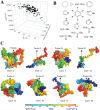Targeting the intrinsically disordered structural ensemble of α-synuclein by small molecules as a potential therapeutic strategy for Parkinson's disease
- PMID: 24551051
- PMCID: PMC3925190
- DOI: 10.1371/journal.pone.0087133
Targeting the intrinsically disordered structural ensemble of α-synuclein by small molecules as a potential therapeutic strategy for Parkinson's disease
Erratum in
- PLoS One. 2014;9(5):e99274
Abstract
The misfolding of intrinsically disordered proteins such as α-synuclein, tau and the Aβ peptide has been associated with many highly debilitating neurodegenerative syndromes including Parkinson's and Alzheimer's diseases. Therapeutic targeting of the monomeric state of such intrinsically disordered proteins by small molecules has, however, been a major challenge because of their heterogeneous conformational properties. We show here that a combination of computational and experimental techniques has led to the identification of a drug-like phenyl-sulfonamide compound (ELN484228), that targets α-synuclein, a key protein in Parkinson's disease. We found that this compound has substantial biological activity in cellular models of α-synuclein-mediated dysfunction, including rescue of α-synuclein-induced disruption of vesicle trafficking and dopaminergic neuronal loss and neurite retraction most likely by reducing the amount of α-synuclein targeted to sites of vesicle mobilization such as the synapse in neurons or the site of bead engulfment in microglial cells. These results indicate that targeting α-synuclein by small molecules represents a promising approach to the development of therapeutic treatments of Parkinson's disease and related conditions.
Conflict of interest statement
Figures


References
-
- Dawson TM, Dawson VL (2003) Molecular pathways of neurodegeneration in Parkinson's disease. Science 302: 819–822. - PubMed
-
- Spillantini MG, Schmidt ML, Lee VM, Trojanowski JQ, Jakes R, et al. (1997) Alpha-synuclein in Lewy bodies. Nature 388: 839–840. - PubMed
-
- Lucking CB, Durr A, Bonifati V, Vaughan J, De Michele G, et al. (2000) Association between early-onset Parkinson's disease and mutations in the parkin gene. The New England journal of medicine 342: 1560–1567. - PubMed
-
- Schiesling C, Kieper N, Seidel K, Kruger R (2008) Review: Familial Parkinson's disease–genetics, clinical phenotype and neuropathology in relation to the common sporadic form of the disease. Neuropathology and applied neurobiology 34: 255–271. - PubMed
-
- Polymeropoulos MH, Lavedan C, Leroy E, Ide SE, Dehejia A, et al. (1997) Mutation in the alpha-synuclein gene identified in families with Parkinson's disease. Science 276: 2045–2047. - PubMed
Publication types
MeSH terms
Substances
Grants and funding
LinkOut - more resources
Full Text Sources
Other Literature Sources
Medical

